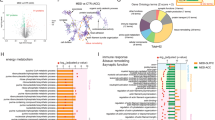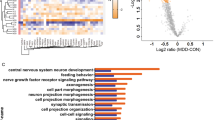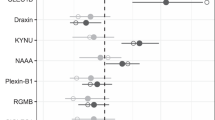Abstract
Bipolar affective disorder is a severe and debilitating psychiatric condition characterized by the alternating mood states of mania and depression. Both the molecular pathophysiology of the disorder and the mechanism of action of the mainstays of its treatment remain largely unknown. Here, 1H NMR spectroscopy-based metabonomic analysis was performed to identify molecular changes in post-mortem brain tissue (dorsolateral prefrontal cortex) of patients with a history of bipolar disorder. The observed changes were then compared to metabolic alterations identified in rat brain following chronic oral treatment with either lithium or valproate. This is the first study to use 1H NMR spectroscopy to study post-mortem bipolar human brain tissue, and it is the first to compare changes in disease brain with changes induced in rat brain following mood stabilizer treatment. Several metabolites were found to be concordantly altered in both the animal and human tissues. Glutamate levels were increased in post-mortem bipolar brain, while the glutamate/glutamine ratio was decreased following valproate treatment, and γ-aminobutyric acid levels were increased after lithium treatment, suggesting that the balance of excitatory/inhibitory neurotransmission is central to the disorder. Both creatine and myo-inositol were increased in the post-mortem brain but depleted with the medications. Lastly, the level of N-acetyl aspartate, a clinically important metabolic marker of neuronal viability, was found to be unchanged following chronic mood stabilizer treatment. These findings promise to provide new insight into the pathophysiology of bipolar disorder and may be used to direct research into novel therapeutic strategies.
This is a preview of subscription content, access via your institution
Access options
Subscribe to this journal
Receive 12 print issues and online access
$259.00 per year
only $21.58 per issue
Buy this article
- Purchase on Springer Link
- Instant access to full article PDF
Prices may be subject to local taxes which are calculated during checkout


Similar content being viewed by others
References
Weissman MM, Bland RC, Canino GJ, Faravelli C, Greenwald S, Hwu HG et al. Cross-national epidemiology of major depression and bipolar disorder. JAMA 1996; 276: 293–299.
Belmaker RH . Bipolar disorder. N Engl J Med 2004; 351: 476–486.
Ren M, Leng Y, Jeong M, Leeds PR, Chuang DM . Valproic acid reduces brain damage induced by transient focal cerebral ischemia in rats: potential roles of histone deacetylase inhibition and heat shock protein induction. J Neurochem 2004; 89: 1358–1367.
Jeong MR, Hashimoto R, Senatorov VV, Fujimaki K, Ren M, Lee MS et al. Valproic acid, a mood stabilizer and anticonvulsant, protects rat cerebral cortical neurons from spontaneous cell death: a role of histone deacetylase inhibition. FEBS Lett 2003; 542: 74–78.
Nonaka S, Hough CJ, Chuang DM . Chronic lithium treatment robustly protects neurons in the central nervous system against excitotoxicity by inhibiting N-methyl-D-aspartate receptor-mediated calcium influx. Proc Natl Acad Sci USA 1998; 95: 2642–2647.
Xu J, Culman J, Blume A, Brecht S, Gohlke P . Chronic treatment with a low dose of lithium protects the brain against ischemic injury by reducing apoptotic death. Stroke 2003; 34: 1287–1292.
Chen G, Zeng WZ, Yuan PX, Huang LD, Jiang YM, Zhao ZH et al. The mood-stabilizing agents lithium and valproate robustly increase the levels of the neuroprotective protein bcl-2 in the CNS. J Neurochem 1999; 72: 879–882.
Einat H, Yuan P, Gould TD, Li J, Du J, Zhang L et al. The role of the extracellular signal-regulated kinase signaling pathway in mood modulation. J Neurosci 2003; 23: 7311–7316.
Moore GJ, Bebchuk JM, Wilds IB, Chen G, Manji HK . Lithium-induced increase in human brain grey matter. Lancet 2000; 356: 1241–1242.
Brambilla P, Stanley JA, Nicoletti MA, Sassi RB, Mallinger AG, Frank E et al. 1H magnetic resonance spectroscopy investigation of the dorsolateral prefrontal cortex in bipolar disorder patients. J Affect Disord 2005; 86: 61–67.
Moore GJ, Bebchuk JM, Hasanat K, Chen G, Seraji-Bozorgzad N, Wilds IB et al. Lithium increases N-acetyl-aspartate in the human brain: in vivo evidence in support of bcl-2's neurotrophic effects? Biol Psychiatry 2000; 48: 1–8.
Bachmann RF, Schloesser RJ, Gould TD, Manji HK . Mood stabilizers target cellular plasticity and resilience cascades: implications for the development of novel therapeutics. Mol Neurobiol 2005; 32: 173–202.
Nicholson JK, Lindon JC, Holmes E . ‘Metabonomics’: understanding the metabolic responses of living systems to pathophysiological stimuli via multivariate statistical analysis of biological NMR spectroscopic data. Xenobiotica 1999; 29: 1181–1189.
Tsang TM, Griffin JL, Haselden J, Fish C, Holmes E . Metabolic characterization of distinct neuroanatomical regions in rats by magic angle spinning 1H nuclear magnetic resonance spectroscopy. Magn Reson Med 2005; 53: 1018–1024.
Holmes E, Tsang TM, Huang JT, Leweke FM, Koethe D, Gerth CW et al. Metabolic profiling of CSF: evidence that early intervention may impact on disease progression and outcome in schizophrenia. PLoS Med 2006; 3: e327.
Prabakaran S, Swatton JE, Ryan MM, Huffaker SJ, Huang JT, Griffin JL et al. Mitochondrial dysfunction in schizophrenia: evidence for compromised brain metabolism and oxidative stress. Mol Psychiatry 2004; 9: 684–697,643.
Holmes E, Tsang TM, Huang JT, Leweke FM, Koethe D, Gerth CW et al. Metabolic profiling of CSF: evidence that early intervention may impact on disease progression and outcome in schizophrenia. PLoS Med 2006; 3: e327.
Tsang TM, Huang JT, Holmes E, Bahn S . Metabolic profiling of plasma from discordant schizophrenia twins: correlation between lipid signals and global functioning in female schizophrenia patients. J Proteome Res 2006; 5: 756–760.
Huang JT, Leweke FM, Tsang TM, Koethe D, Kranaster L, Gerth CW et al. CSF metabolic and proteomic profiles in patients prodromal for psychosis. PLoS ONE 2007; 2: e756.
Cheng LL, Newell K, Mallory AE, Hyman BT, Gonzalez RG . Quantification of neurons in Alzheimer and control brains with ex vivo high resolution magic angle spinning proton magnetic resonance spectroscopy and stereology. Magn Reson Imaging 2002; 20: 527–533.
Tsang TM, Woodman B, McLoughlin GA, Griffin JL, Tabrizi SJ, Bates GP et al. Metabolic characterization of the R6/2 transgenic mouse model of Huntington's disease by high-resolution MAS 1H NMR spectroscopy. J Proteome Res 2006; 5: 483–492.
Pears MR, Cooper JD, Mitchison HM, Mortishire-Smith RJ, Pearce DA, Griffin JL . High resolution 1H NMR-based metabolomics indicates a neurotransmitter cycling deficit in cerebral tissue from a mouse model of Batten disease. J Biol Chem 2005; 280: 42508–42514.
Barton SJ, Howe FA, Tomlins AM, Cudlip SA, Nicholson JK, Bell BA et al. Comparison of in vivo 1H MRS of human brain tumours with 1H HR-MAS spectroscopy of intact biopsy samples in vitro. Magma 1999; 8: 121–128.
Holmes E, Tsang TM, Tabrizi SJ . The application of NMR-based metabonomics in neurological disorders. NeuroRx 2006; 3: 358–372.
Lenz EM, Wilson ID . Analytical strategies in metabonomics. J Proteome Res 2007; 6: 443–458.
Strakowski SM, Delbello MP, Adler CM . The functional neuroanatomy of bipolar disorder: a review of neuroimaging findings. Mol Psychiatry 2005; 10: 105–116.
Rajkowska G . Postmortem studies in mood disorders indicate altered numbers of neurons and glial cells. Biol Psychiatry 2000; 48: 766–777.
Torrey EF, Webster M, Knable M, Johnston N, Yolken RH . The Stanley Foundation brain collection and neuropathology consortium. Schizophr Res 2000; 44: 151–155.
Garrod S, Humpfer E, Spraul M, Connor SC, Polley S, Connelly J et al. High-resolution magic angle spinning 1H NMR spectroscopic studies on intact rat renal cortex and medulla. Magn Reson Med 1999; 41: 1108–1118.
Foxall PJ, Nicholson JK . Nuclear magnetic resonance spectroscopy: a non-invasive probe of kidney metabolism and function. Exp Nephrol 1998; 6: 409–414.
Wold S, Albano C, Dunn WJ, Edlund U, Esbendsen K, Geladi P et al. Multivariate Data Analysis in Chemistry. Reidel Publishing: Dordrecht, 1984.
Hoskuldsson A . Prediction Methods in Science and Technology. Thor Publishing: Copenhagen, 1996.
Cloarec O, Dumas ME, Trygg J, Craig A, Barton RH, Lindon JC et al. Evaluation of the orthogonal projection on latent structure model limitations caused by chemical shift variability and improved visualization of biomarker changes in 1H NMR spectroscopic metabonomic studies. Anal Chem 2005; 77: 517–526.
Yildiz-Yesiloglu A, Ankerst DP . Neurochemical alterations of the brain in bipolar disorder and their implications for pathophysiology: a systematic review of the in vivo proton magnetic resonance spectroscopy findings. Prog Neuropsychopharmacol Biol Psychiatry 2006; 30: 969–995.
Davanzo P, Thomas MA, Yue K, Oshiro T, Belin T, Strober M et al. Decreased anterior cingulate myo-inositol/creatine spectroscopy resonance with lithium treatment in children with bipolar disorder. Neuropsychopharmacology 2001; 24: 359–369.
Moore CM, Breeze JL, Gruber SA, Babb SM, Frederick BB, Villafuerte RA et al. Choline, myo-inositol and mood in bipolar disorder: a proton magnetic resonance spectroscopic imaging study of the anterior cingulate cortex. Bipolar Disord 2000; 2(3 Part 2): 207–216.
Sassi RB, Stanley JA, Axelson D, Brambilla P, Nicoletti MA, Keshavan MS et al. Reduced NAA levels in the dorsolateral prefrontal cortex of young bipolar patients. Am J Psychiatry 2005; 162: 2109–2115.
Frey BN, Folgierini M, Nicoletti M, Machado-Vieira R, Stanley JA, Soares JC et al. A proton magnetic resonance spectroscopy investigation of the dorsolateral prefrontal cortex in acute mania. Hum Psychopharmacol 2005; 20: 133–139.
Dager SR, Friedman SD, Parow A, Demopulos C, Stoll AL, Lyoo IK et al. Brain metabolic alterations in medication-free patients with bipolar disorder. Arch Gen Psychiatry 2004; 61: 450–458.
Glowinski J, Axelrod J . Inhibition of uptake of tritiated-noradrenaline in the intact rat brain by imipramine and structurally related compounds. Nature 1964; 204: 1318–1319.
Harwood AJ . Lithium and bipolar mood disorder: the inositol-depletion hypothesis revisited. Mol Psychiatry 2005; 10: 117–126.
O'Donnell T, Rotzinger S, Nakashima TT, Hanstock CC, Ulrich M, Silverstone PH . Chronic lithium and sodium valproate both decrease the concentration of myo-inositol and increase the concentration of inositol monophosphates in rat brain. Brain Res 2000; 880: 84–91.
Strange K, Emma F, Paredes A, Morrison R . Osmoregulatory changes in myo-inositol content and Na+/myo-inositol cotransport in rat cortical astrocytes. Glia 1994; 12: 35–43.
Brand A, Richter-Landsberg C, Leibfritz D . Multinuclear NMR studies on the energy metabolism of glial and neuronal cells. Dev Neurosci 1993; 15: 289–298.
Shaltiel G, Shamir A, Shapiro J, Ding D, Dalton E, Bialer M et al. Valproate decreases inositol biosynthesis. Biol Psychiatry 2004; 56: 868–874.
E Hertz GA, Richards M, Belmaker RH . Lithium–inositol interactions: synthesis, uptake, turnover. In: Honig A and HM van Praag (ed). Depression: Neurobiological, Psychopathological and Therapeutic Advances. John Wiley: Chichester, 1997, pp 519–534.
Lubrich B, van Calker D . Inhibition of the high affinity myo-inositol transport system: a common mechanism of action of antibipolar drugs? Neuropsychopharmacology 1999; 21: 519–529.
Moore GJ, Bebchuk JM, Parrish JK, Faulk MW, Arfken CL, Strahl-Bevacqua J et al. Temporal dissociation between lithium-induced changes in frontal lobe myo-inositol and clinical response in manic-depressive illness. Am J Psychiatry 1999; 156: 1902–1908.
Kato T . Mitochondrial dysfunction in bipolar disorder: from 31P-magnetic resonance spectroscopic findings to their molecular mechanisms. Int Rev Neurobiol 2005; 63: 21–40.
Konradi C, Eaton M, MacDonald ML, Walsh J, Benes FM, Heckers S . Molecular evidence for mitochondrial dysfunction in bipolar disorder. Arch Gen Psychiatry 2004; 61: 300–308.
Iwamoto K, Bundo M, Kato T . Altered expression of mitochondria-related genes in postmortem brains of patients with bipolar disorder or schizophrenia, as revealed by large-scale DNA microarray analysis. Hum Mol Genet 2005; 14: 241–253.
MacDonald ML, Naydenov A, Chu M, Matzilevich D, Konradi C . Decrease in creatine kinase messenger RNA expression in the hippocampus and dorsolateral prefrontal cortex in bipolar disorder. Bipolar Disord 2006; 8: 255–264.
Xu CJ, Klunk WE, Kanfer JN, Xiong Q, Miller G, Pettegrew JW . Phosphocreatine-dependent glutamate uptake by synaptic vesicles. A comparison with atp-dependent glutamate uptake. J Biol Chem 1996; 271: 13435–13440.
Andreassen OA, Jenkins BG, Dedeoglu A, Ferrante KL, Bogdanov MB, Kaddurah-Daouk R et al. Increases in cortical glutamate concentrations in transgenic amyotrophic lateral sclerosis mice are attenuated by creatine supplementation. J Neurochem 2001; 77: 383–390.
Pettegrew JW, Panchalingam K, McClure RJ, Gershon S, Muenz LR, Levine J . Effects of chronic lithium administration on rat brain phosphatidylinositol cycle constituents, membrane phospholipids and amino acids. Bipolar Disord 2001; 3: 189–201.
van den Berg CJ, Garfinkel D . A stimulation study of brain compartments. Metabolism of glutamate and related substances in mouse brain. Biochem J 1971; 123: 211–218.
Drevets WC, Price JL, Simpson Jr JR, Todd RD, Reich T, Vannier M et al. Subgenual prefrontal cortex abnormalities in mood disorders. Nature 1997; 386: 824–827.
Strakowski SM, Adler CM, Holland SK, Mills NP, DelBello MP, Eliassen JC . Abnormal FMRI brain activation in euthymic bipolar disorder patients during a counting Stroop interference task. Am J Psychiatry 2005; 162: 1697–1705.
Chang K, Adleman NE, Dienes K, Simeonova DI, Menon V, Reiss A . Anomalous prefrontal-subcortical activation in familial pediatric bipolar disorder: a functional magnetic resonance imaging investigation. Arch Gen Psychiatry 2004; 61: 781–792.
Ketter TA, Kimbrell TA, George MS, Dunn RT, Speer AM, Benson BE et al. Effects of mood and subtype on cerebral glucose metabolism in treatment-resistant bipolar disorder. Biol Psychiatry 2001; 49: 97–109.
Buchsbaum MS, Wu J, DeLisi LE, Holcomb H, Kessler R, Johnson J et al. Frontal cortex and basal ganglia metabolic rates assessed by positron emission tomography with [18F]2-deoxyglucose in affective illness. J Affect Disord 1986; 10: 137–152.
Shen J . 13C magnetic resonance spectroscopy studies of alterations in glutamate neurotransmission. Biol Psychiatry 2006; 59: 883–887.
Gottesfeld Z, Ebstein BS, Samuel D . Effect of lithium on concentrations of glutamate and GABA levels in amygdala and hypothalamus of rat. Nat New Biol 1971; 234: 124–125.
Ahluwalia P, Grewaal DS, Singhal RL . Brain gabaergic and dopaminergic systems following lithium treatment and withdrawal. Prog Neuropsychopharmacol 1981; 5: 527–530.
Antonelli T, Ferioli V, Lo Gallo G, Tomasini MC, Fernandez M, O'Connor WT et al. Differential effects of acute and short-term lithium administration on dialysate glutamate and GABA levels in the frontal cortex of the conscious rat. Synapse 2000; 38: 355–362.
Motohashi N, Ikawa K, Kariya T . GABAB receptors are up-regulated by chronic treatment with lithium or carbamazepine. GABA hypothesis of affective disorders? Eur J Pharmacol 1989; 166: 95–99.
Hipps PP, Holland WH, Sherman WR . Interconversion of myo- and scyllo-inositol with simultaneous formation of neo-inositol by an NADP+ dependent epimerase from bovine brain. Biochem Biophys Res Commun 1977; 77: 340–346.
Pellerin L . Lactate as a pivotal element in neuron–glia metabolic cooperation. Neurochem Int 2003; 43: 331–338.
Schurr A, Payne RS, Tseng MT, Gozal E, Gozal D . Excitotoxic preconditioning elicited by both glutamate and hypoxia and abolished by lactate transport inhibition in rat hippocampal slices. Neurosci Lett 2001; 307: 151–154.
Ros J, Pecinska N, Alessandri B, Landolt H, Fillenz M . Lactate reduces glutamate-induced neurotoxicity in rat cortex. J Neurosci Res 2001; 66: 790–794.
Rapoport SI, Bosetti F . Do lithium and anticonvulsants target the brain arachidonic acid cascade in bipolar disorder? Arch Gen Psychiatry 2002; 59: 592–596.
Bosetti F, Rintala J, Seemann R, Rosenberger TA, Contreras MA, Rapoport SI et al. Chronic lithium downregulates cyclooxygenase-2 activity and prostaglandin E(2) concentration in rat brain. Mol Psychiatry 2002; 7: 845–850.
Bosetti F, Weerasinghe GR, Rosenberger TA, Rapoport SI . Valproic acid down-regulates the conversion of arachidonic acid to eicosanoids via cyclooxygenase-1 and -2 in rat brain. J Neurochem 2003; 85: 690–696.
Yao FS, Caserta MT, Wyrwicz AM . In vitro proton and phosphorus NMR spectroscopic analysis of murine (C57Bl/6J) brain development. NMR Biomed 1999; 12: 463–470.
Valenzuela MJ, Sachdev P . Magnetic resonance spectroscopy in AD. Neurology 2001; 56: 592–598.
Saunders DE . MR spectroscopy in stroke. Br Med Bull 2000; 56: 334–345.
Brambilla P, Stanley JA, Sassi RB, Nicoletti MA, Mallinger AG, Keshavan MS et al. 1H MRS study of dorsolateral prefrontal cortex in healthy individuals before and after lithium administration. Neuropsychopharmacology 2004; 29: 1918–1924.
O'Donnell T, Rotzinger S, Ulrich M, Hanstock CC, Nakashima TT, Silverstone PH . Effects of chronic lithium and sodium valproate on concentrations of brain amino acids. Eur Neuropsychopharmacol 2003; 13: 220–227.
Acknowledgements
This research was supported by the Stanley Medical Research Institute and the donations of the Stanley brain collection courtesy of Drs Michael B Knable, E Fuller Torrey and Robert H Yolken. Special thanks to Dr Maree Webster for providing post-mortem brain samples. Thanks to all members of the Bahn Laboratory for discussions, help and encouragement. Most of all, thanks to all patients and healthy volunteers for their selfless donation of samples used in this study. MJL is the recipient of an NIH–Cambridge health scholarship and GAMcL is funded by the METAGRAD project (supported by AstraZeneca and Unilever). SB holds a NARSAD Essel Independent Investigator Fellowship.
Author information
Authors and Affiliations
Corresponding author
Additional information
Supplementary Information accompanies the paper on the Molecular Psychiatry website (http://www.nature.com/mp)
Supplementary information
Rights and permissions
About this article
Cite this article
Lan, M., McLoughlin, G., Griffin, J. et al. Metabonomic analysis identifies molecular changes associated with the pathophysiology and drug treatment of bipolar disorder. Mol Psychiatry 14, 269–279 (2009). https://doi.org/10.1038/sj.mp.4002130
Received:
Revised:
Accepted:
Published:
Issue Date:
DOI: https://doi.org/10.1038/sj.mp.4002130
Keywords
This article is cited by
-
Gut microbiota and its relation to inflammation in patients with bipolar depression: a cross-sectional study
Annals of General Psychiatry (2023)
-
Consolidation of metabolomic, proteomic, and GWAS data in connective model of schizophrenia
Scientific Reports (2023)
-
Metabolomic biomarkers related to non-suicidal self-injury in patients with bipolar disorder
BMC Psychiatry (2022)
-
Disrupting the α7nAChR–NR2A protein complex exerts antidepressant-like effects
Molecular Brain (2021)
-
Effects of tamoxifen and glutamate and glutamine levels in brain regions in repeated sleep deprivation–induced mania model in mice
Naunyn-Schmiedeberg's Archives of Pharmacology (2021)



